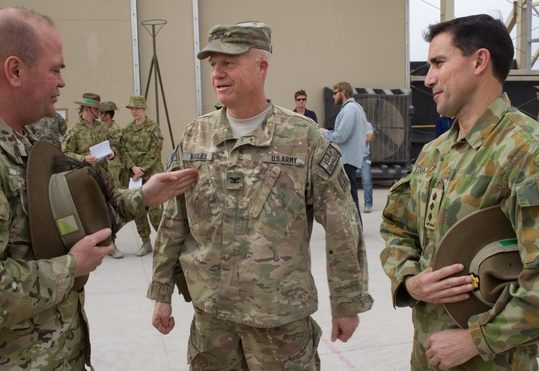
The AUKUS pact, which stands as a testament to the collaborative defense efforts of the U.S., U.K., and Australia, has garnered significant attention for its potential to reshape military dynamics in the Indo-Pacific.

The pact’s second pillar, focusing on critical technologies like AI, quantum computing, and hypersonics, is accelerating the integration of advanced capabilities into land forces.

This integration is crucial as the U.S. Army’s 3rd Multidomain Task Force (MDTF), based in Hawaii, welcomes officers from Australia and the U.K. to advance these technologies, a clear indication of the growing importance of joint interoperability and capability development.

During a recent panel discussion titled “A Conversation with the AUKUS Army Chiefs on Land Power’s Contribution to AUKUS Pillar 2,” the army chiefs from the three AUKUS nations outlined the significance of land power in addressing emerging challenges in the Indo-Pacific and beyond.

U.S. Gen. Randy George underscored the necessity for continuous transformation, indicating that the current volatile global environment demands rapid adaptability and innovation. He highlighted unmanned systems, counter-unmanned systems, and long-range precision fires as key focus areas requiring immediate attention.

Echoing the sentiment of integration, Australian Lt. Gen. Simon Stuart emphasized the Australian Army’s transformation towards littoral maneuver operations, explaining the importance of leveraging the land-sea interface for positional advantage and multidomain effects.

He pointed out the need for speed and relevancy in adapting to technological advancements, particularly in data sharing and long-range precision fires.

British Gen. Sir Patrick Sanders advocated for a transformational approach, urging a departure from traditional structures and processes in favor of a tolerance for risk and priority-driven development.

He emphasized the evolving nature of warfare, as witnessed in Ukraine, and how autonomous systems and data flow are revolutionizing military operations.

The panelists also addressed the private sector’s role, encouraging companies to focus on cyber technologies, artificial intelligence, and ethical considerations as foundational elements for future capabilities.

They highlighted the importance of the industry’s involvement in meeting the rapid pace of military technology advancement and the shared responsibility of maintaining the rules-based order.

Moreover, the conversation touched upon the notion of the “gray zone” and how it reflects the challenges that traditional military capabilities face in contemporary conflict environments.

Rather than a distinct domain, the gray zone represents a spectrum of activities that fall below the threshold of armed conflict, necessitating a nuanced understanding and response.

The AUKUS army chiefs’ discussion did not specifically target any nation but served as a reminder of the collective commitment to upholding the global order.

The land power’s evolving role, as detailed by the chiefs, is a clarion call for innovative solutions and stronger partnerships in safeguarding security and stability in the Indo-Pacific region and beyond.
Relevant articles:
– Here’s how the US Army’s multidomain task force is contributing to AUKUS, Defense News
– A Conversation with the AUKUS Army Chiefs on Land Power’s Contribution to AUKUS Pillar 2, CSIS | Center for Strategic and International Studies
